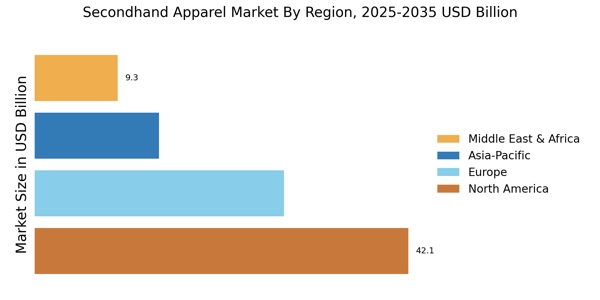The Secondhand Apparel Market is currently characterized by a dynamic competitive landscape, driven by increasing consumer demand for sustainable fashion and the growing acceptance of pre-owned goods. Key players such as ThredUp (US), Poshmark (US), and Vestiaire Collective (FR) are strategically positioning themselves to capitalize on these trends. ThredUp (US) focuses on innovation through its technology-driven platform, enhancing user experience and streamlining the resale process. Poshmark (US) emphasizes community engagement, leveraging social features to foster a vibrant marketplace. Meanwhile, Vestiaire Collective (FR) targets the luxury segment, promoting authenticity and quality, which differentiates it from other players in the market. Collectively, these strategies contribute to a competitive environment that is increasingly centered around consumer experience and brand trust.
In terms of business tactics, companies are increasingly localizing their operations and optimizing supply chains to enhance efficiency and reduce environmental impact. The market structure appears moderately fragmented, with numerous players vying for market share, yet the influence of major companies is palpable. This competitive structure allows for a diverse range of offerings, catering to various consumer preferences and price points, while also fostering innovation as companies strive to differentiate themselves.
In September 2025, ThredUp (US) announced a partnership with a major retail brand to launch a co-branded resale platform, which is expected to significantly expand its reach and customer base. This strategic move not only enhances ThredUp's visibility but also aligns with the growing trend of retailers embracing resale as a means to engage eco-conscious consumers. The partnership could potentially set a precedent for other companies in the sector, indicating a shift towards collaborative models in the secondhand market.
In August 2025, Poshmark (US) introduced advanced AI-driven features to enhance its search and recommendation capabilities, aiming to improve user engagement and sales conversion rates. This technological advancement reflects a broader trend within the industry, where digital transformation is becoming essential for maintaining competitive advantage. By leveraging AI, Poshmark (US) positions itself as a forward-thinking platform that prioritizes user experience, which may attract a larger audience and increase transaction volumes.
In July 2025, Vestiaire Collective (FR) launched a new initiative aimed at increasing transparency in its supply chain, which includes detailed provenance information for each item sold. This move is particularly significant as consumers are increasingly demanding accountability from brands regarding sustainability practices. By enhancing transparency, Vestiaire Collective (FR) not only strengthens its brand reputation but also aligns itself with the values of its target demographic, potentially driving customer loyalty and repeat purchases.
As of October 2025, the competitive trends within the Secondhand Apparel Market are heavily influenced by digitalization, sustainability, and the integration of advanced technologies such as AI. Strategic alliances are becoming more prevalent, as companies recognize the value of collaboration in enhancing their market positions. Looking ahead, it is likely that competitive differentiation will increasingly pivot from traditional price-based competition to a focus on innovation, technological integration, and supply chain reliability. This evolution suggests that companies that can effectively leverage these trends will be better positioned to thrive in the rapidly changing landscape of secondhand apparel.


















Leave a Comment